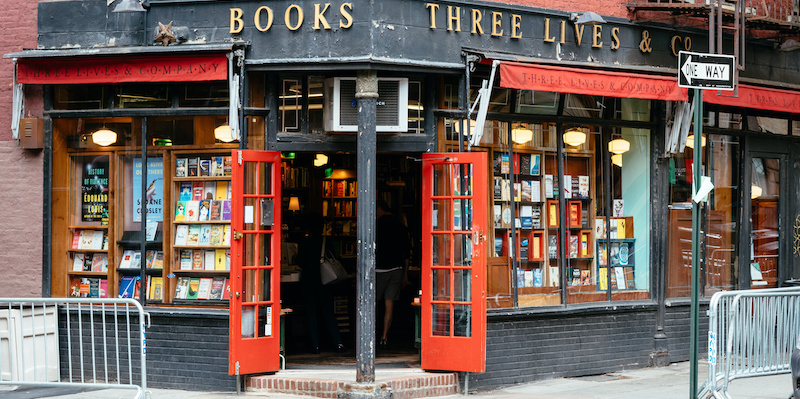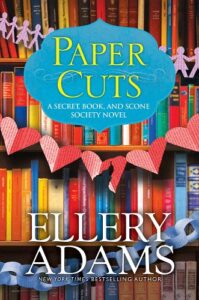“Bookstores are lonely forts, spilling light onto the sidewalk. They civilize their neighbourhoods.” – John Updike
John Updike clearly understood one of the main appeals of the bookstore. As readers, we can easily picture our favorite bookshops as forts. Our ramparts are built out of wooden shelves and a kaleidoscope of book spines. When we pass through the door, we are gratefully walled off from a chaotic and noisy world. Why, then, is this utopian structure lonely?
Bookstores are lonely in the same way a lighthouse is lonely. It sits on its scrap of real estate, shining like a beacon in a storm, and guides us to our safe harbor. It offers us asylum and hope. So, what makes this utopia such an ideal place for murder?
The bookish community is smaller than one might think. Publishers, authors, reviewers, librarians, and readers are more connected than ever in this digital age. What connects us all is our passion for books. And we all know that misguided passion can turn into something rotten.
Something deadly.
John Dunning’s award-winning Cliff Janeway series gave me my first taste of a bibliomystery. Dunning owned a bookstore in Denver, as did his homicide detective hero. Even though it’s probably been fifteen years since I read Booked to Die, I still remember Dunning’s incredible insight regarding antiquarian books and human nature. A book collector is no less zealous than a collector of fine art or rare jewels, and Dunning’s villains are willing to cross any line to get their hands on that signed first edition or ancient tome. This is a smart, page-turning series for all mystery lovers.
Booked to Die was published in 1991. An older example of a bibliomystery is Murder in the Bookshop by Carolyn Wells. Written in 1939, this classic detective novel centers around the disappearance of a book worth a whopping $100,000. There’s a body in the bookstore, another set of maniacal collectors, and a bookish detective called Fleming Stone.
Wells’s series is set in New York, which is where the author of another celebrated bookshop series hails from. Lorna Barrett pens one of the original cozy mystery series set in a bookstore. Starting with Murder is Binding (2008), the fictional town of Stoneham, New Hampshire, is revitalized when several specialized bookstores set up shop. The main action occurs in Haven’t Got a Clue, a mystery-themed bookstore. Other stores include books for cooks, animal lovers, romance fans, and crafters. With a study influx of tourists and stiff competition between booksellers, Barrett’s “Booktown” becomes the perfect setting for murder. At seventeen books and counting, readers can return to Stoneham again and again.
The list of cozy mysteries in which the main character owns a bookstore is long and varied. In addition to mystery bookshop series like The Mystery Bookshop Mysteries by V.M. Burns and The Sherlock Holmes Bookshop Mysteries by Vicki Delany, there are also bookstores for coffee lovers, like Lynn Cahoon’s Tourist Trap Mysteries. Food and bookstores are a natural pairing, and readers can get their fill of both with Abby Collette’s soul food mysteries. Foodies will also enjoy Ellen Byron’s Vintage Cookbook Mysteries.
Anglophiles have plenty of bookstore mysteries to choose from, including Margaret Loundon’s Open Book Mysteries, Elizabeth Penny’s Cambridge Bookshop Mysteries, and Elizabeth Blake’s Jane Austen Society Mysteries (set in North Yorkshire), to name a few. Keep traveling north to visit Paige Shelton’s Scottish Bookshop Mysteries.
The bookstores in cozy mysteries have it all. Books, coffee, pastries, and a cute cat. They even have ghosts (Alice Kimberly’s Haunted Bookshop Mysteries) or magic (Amanda Flowers’s Magical Bookshop Mysteries).
But the main appeal of these cozies resides in their sense of community. As readers, we want to enter these charming bookstores—to hear the jingle of bells as we step into a space smelling of vanilla, coffee, and old paper. We want to be included. We long to help the amateur sleuth rebalance the scales of justice. These fictional bookstores offer us a respite from our noisy, busy lives. Recurring characters become friends. We become so invested in these small towns—of which the bookstore is inexorably the heart—that we begin to picture ourselves as residents.
It was this feeling of community that inspired me to create Miracle Springs. This fictitious town in western North Carolina is loosely based on a real place called Hot Springs. For centuries, people have visited the springs for their healing powers.
Like all the best bookstores, Miracle Books is a bit of a rabbit warren. One can get lost in the stacks or spend hours in a well-worn reading chair. One can have a quiet coffee with friends or a lively book club meeting.
What sets this bookstore apart is its proprietor. Nora Pennington, a former librarian and burn survivor, uses her knowledge of books and an inexhaustible supply of empathy to help certain customers heal from emotional wounds. These customers enter Miracle Books in despair and leave feeling hopeful, thanks to this untrained bibliotherapist and bookshop proprietor.
The Secret, Book, and Scone Society was born inside Miracle Books. Inside this old train station building, the characters confide and conspire. In the beginning of the series, the four women who become The Secret, Book, and Scone Society are acutely lonely, but by the end of the first book, their loneliness has been banished. Their friendship arises from their love of books and a desire for justice. In that sense, they have much in common with cozy mystery readers.
A sense of community is the true appeal of the bookstore setting. Bookstores in mysteries promise warmth and calm. They offer companionship. When all seems dark and dreary, they are there, “spilling light onto the sidewalk.”
***


















